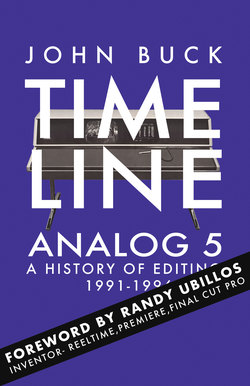Читать книгу Timeline Analog 5 - John Buck - Страница 19
На сайте Литреса книга снята с продажи.
PREMIERE 1.0
ОглавлениеAdobe became a multimedia company at the San Francisco MacWorld in January 1992.
(Premiere) allows you to create digital “movies” on the desktop is shipping now and demand is overwhelming.
Premiere displayed tracks in filmstrip style, allowing the user to see different strips for different video sources, special effects, superimposed titles, and soundtracks. The user was expected to edit the raw material into a movie, using the Construction window to sequence and manipulate multiple tracks of sounds and images.
Intermediate results were viewed in a Preview window.
Randy Ubillos recalls:
We launched Premiere but it was, of course, limited in its functionality in the same way as ReelTime. It couldn't capture, you had to get the files into the system by other means and then import them into Premiere. And because it was completed before QuickTime was released, it wasn't optimized for QuickTime. It worked OK.
Adobe expected Premiere to be used by web content creators, those who needed to edit QuickTime movies already within the Mac.
Once a project was completed, the result could be played on a computer screen or burnt to a CD. Premiere could not capture audio or video.
Its ‘Print to Video’ function simply created a QuickTime movie of the edit sequence that could be transferred to videotape, as long as the user had the necessary video and audio output hardware.
The press release stated:
Editing of analog video is currently outside the scope of Premiere, but it may be included in the future as Apple adds machine-control features to QuickTime.
Software specialist Loran Kary had seen ReelTime at SuperMac.
Adobe Premiere Version 1 was a pretty basic program because it could not control videotape machines or laserdiscs to perform actual timecode video editing. With a lack of support for timecode and no EDL support, you couldn't really perform off-line editing.
You had no way of taking an edit to an on-line bay. In fact, I can't remember how you even got material onto the drives! It didn't even have digitising capabilities.
The shipping Premiere product may not have been considered a threat to professional systems made by Avid and EMC but it caused problems elsewhere. VP of sales and marketing at Digital F/X.
Roger Siminoff remembers:
Its impact was immediate. Here was Digital F/X in a last ditch effort to stay alive and trying to compete at a $10,000 price point, down from $100,000 for the original Composium and at the turn of a light switch, at the very same show suddenly it was competing with a bundle of Adobe Premiere for $495 and a Radius card.
You could get a whole system for $8000, promising to do the same thing as Video F/X. Adobe also had great digital imaging products like Illustrator and Photoshop, and it completely blew the chair out from under Digital F/X.
Digital F/X’s Michael Olivier adds:
No doubt Premiere Version One was a groundbreaking product at the time, but no professional editors in those days would consider using Premiere. It was a “prosumer” offering: great for enthusiasts on a budget but terrible for 500+ cuts a day editing.
SuperMac VP Laurin Herr looks back:
Was Premiere like Avid? No. Did it offer the editor the same versatility and creative vocabulary and productivity as an Avid? No. Randy Ubillos is a brilliant programmer, but he wasn't an editor.
He had created a new working environment based upon the metaphor he knew well and understood, and that was desktop publishing. Quark, Photoshop and Postscript. He took a different approach, a different metaphor that was brilliant.
Despite the shortcomings for professional editors, Premiere's early adopters were desktop workers, and they loved it. Editor Junior Hansen from the Berkeley Macintosh Users Group was a typical user, amazed at the power that editors now had.
Premiere 1.0 was a visionary Mac application and remains so, even to this day. I'm sure the first cave woman felt the same about fire, once she was able to harness it for soufflés. I had the opportunity to work with a beta version in the ‘early days’ when the idea of dynamic data was just an exciting secret soon to be told, it was instantly intuitive.
The metaphors of film and video editing were employed and recognizable within the interface.
In homage to the days of slicing through film strips and then videotape, Ubillos had included icon design that matched a film editor’s toolset. Hansen Jr concludes:
Tools and objects are representative of their function; a QuickTime movie looks like a strip of film, a razor blade tools cuts just as it would in the real world.
